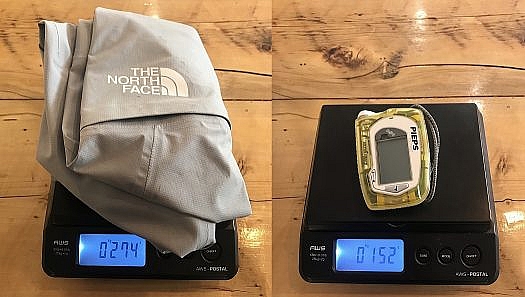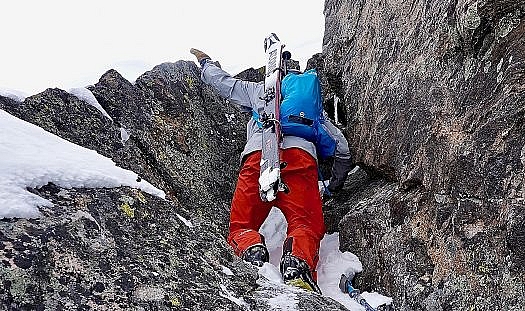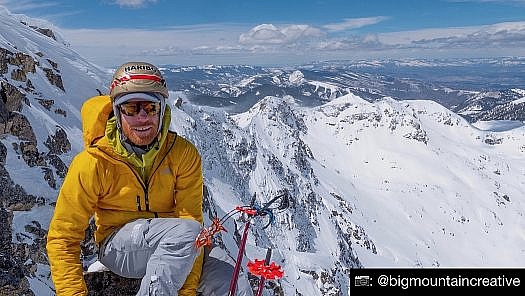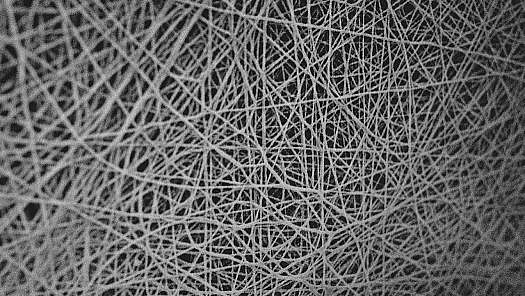This post sponsored by our publishing partner Cripple Creek Backcountry.
Editor’s note: We are attempting to provide you, dear readers, with legible prose. These all-caps product names make the reading stutter. They work fine for titles and such, but they do not work in prose (other than for SHOUTING). Our policy starting now is we’ll use the official ALLCAPS spelling a few times at the start of a post, then we’ll use readable proper case.
Pants as light as the beacon residing in the dedicated thigh pocket? A jacket so remarkably weightless and mobile that the ethereal shell goes unnoticed? Is it possible to comfortably wear a waterproof shell during aerobic activity? These queries are at the core of one of the biggest fabric innovations since 1969, that time long ago when Wilbert and Bob Gore stretched Teflon into a breathable membrane.
The North Face launches “FUTURELIGHT” in their pinnacle product lines (Summit, Steep, and Flight) this coming fall after over 400 days of athlete and laboratory testing. I tested a Summit Series kit for the past eight weeks, as well as learning from friends’ who’ve spent plenty of time using the gear.
First: the science. Futurelight membrane is a nanospun web of recycled synthetics. This sorcery is performed in Korea, where purpose built machines spray the weave from hundreds of thousands of nozzles to create a 4-way stretch membrane that is largely air. Whaaat? As futuristic as this sounds, similar membranes have been achieved by competitors. What TNF brings to the table appears to be a huge positive leap in all directions: air permeability, mobility, and weight reduction; all the while meeting stringent waterproofing standards.
You might have already guessed, but Futurelight is, well, light. 342g and 274g in the medium jacket and pants respectively. Picking up the pants to put on in the morning is almost comical. You might hit yourself in the face your hand comes up so fast. Clothing is often overlooked, obscured by the constant flow of sexy lightweight hardgoods. Years ago I switched from touring in my ski patrol issue Patagonia Rubicon pants into a Polartec Neoshell pant and was shocked by gains that rivaled those of a frame-to-tech binding swap. Futurelight pants are near that jump yet again.

Futurelight pants rivaling the weight of the lightest beacon on the market. A strange feeling when the pocket contents are about the same weight as the pant.
On to the field. I’m no Jim Morrison or Hilaree Nelson and haven’t been up and down Lhotse recently. My testing has consisted of backcountry skiing and light ski mountaineering in Colorado’s high Rockies. Comically illustrating this difference, my first test was an hour groomer lap wearing Futurelight over a full insulation system in an attempt to sweat out my prior evening at the Belly Up club. On this temperate day, I was far less of a sweat bag than I would have been in a conventional waterproof suit. Aspen, where the beer flows like hangover sweat through nanospun membranes.
After more serious testing, away from nightclubs, I’m here to tell you this is probably the most breathable waterproof fabric out there — by a long shot. More, the temperature range of Futurelight is incredible. Days often turn from frigid starts to downright balmy here due to our dry air and proximity to the sun. I have had several afternoons moving briskly in what would normally have been too much base layering, where Futurelight dispersed my heat adequately. This is without the use of armpit or pant side vents, which don’t exist in the future.
Conversely, my spring season base layering system is usually synthetic boxer briefs/t-shirt doubled with synthetic running shorts/sun hoodie. Temperature swings to the downside, and long transitions, have been completely tolerable in said get up despite Futurelight’s faint presence. Though a throw over puffy is always a welcomed friend on ridges and summits.

Spring ski mountaineering in Colorado. Big temperature swings with variable weather handled well by Futurelight.
FUTURELIGHT is so thin and flexible that the fit and feel are unique for a technical garment. It hangs freely from the body lacking self support. Detailed multipanel design, seen across the high end outdoor market, does provide some shape. The articulated knee panels in the pants are particularly nice. The mobility resulting from the combination of the fabric and well thought out design is my favorite attribute of Futurelight.
The pant leg fits perfectly over any light or midweight touring boot such as Alien RS’ and even Hoji boots. Four buckle Tecnica Zero G in its exploded touring mode, not so much. One would think the forthcoming Steep series rendition would aim to accommodate a beef boot.
I am 6’ 150 lbs with a 28” waist and relatively broad shoulders and chest for my otherwise skeletal figure. The medium pants are spot on with a light belt. The jacket shell is great for wearing over a puffy, but quite large on me over a simple base layer like I prefer. I generally opt for a climbing sized softshell and then throw a puffy over as needed. This layering method would be achieved with a small sized Futurelight jacket.
The North Face design team started at the extreme light end of the spectrum with Futurelight prototyping- a fantastic methodology. This approach challenges the necessity of many features we see standard in the industry.
I was enjoying the lack of a snow gaiter for ease of boot adjustment. This however faded in early spring when booting up steep couloirs in deep transitional snow. There are two eyelets sewn in to the hem for stringing a paracord keeper loop under the boot sole. This would help but certainly not as effective as a gaiter.
No vents- no problem. This stuff breathes. Additional boot cuff reinforcement, already on the way in the production models, is a must- I have a handful of holes developing down low. One thigh pocket with an inner mesh pouch and loop for clipping the beacon leash is all you need in a pant. The jacket utilizes standard features seen in current minimalist tops- hem and hood drawstring, brim wire visor reinforcement, one mesh inner pocket, two way zipper, single chest pocket and adjustable Velcro wrist cuffs.
The durability is about as unique as the textile itself. There is a spot worn in the hip of my pant, which I can’t explain. Alternatively, while sloppily cramponing I snagged the non-reinforced area and the fabric only slightly punctured without tearing. The market standard waterproof fabrics have far less stretch and would have torn open in that scenario. I have given one jacket arm a classic tree branch gashing. Friends who have been in the kit longer, and ski the same amount (a lot), have fared even better with durability. The Steep series implementation of Futurelight is intriguing to me as it will have a thicker, higher denier face fabric.

Notorious for his abuse of gear, Doug leading a scramble in the full Futurelight kit. Doug has had his test gear twice as long as myself and is yet to do major damage, even with shenanigans like this.
Wearing Futurelight gives an exciting glimpse of what is to come in mountain sportswear. At the helm of this charge is The North Face and Global GM of Mountain Sports Scott Mellin, local light gear disciple and WildSnow reader. Scott has put together a fantastic team of out-of-house developers and testers to challenge the norms and generate innovation. In the distant future we will press a “waterproof/windproof” button and be enveloped in a molecular cocoon. For the immediate future the weight, breathability, and mobility of this new technology is pretty darn close.
(WildSnow guest blogger Gary Smith is an avid backcountry skier and ski mountaineer residing in Eagle County, Colorado. You can find him at Cripple Creek Backcountry in Vail when he is not in search of steep lines or face shots. Please visit @g.allen.smith on Instagram for ski shots and snippets of mountain life.)
On March 22nd 2021, Gary Smith tragically died in an avalanche outside of Beaver Creek Resort in Colorado. Since 2018, Gary has been a frequent and insightful contributor to WildSnow. From Christmas Eve spent at the Wildsnow Field HQ cabin, to testing gear and sharing his love for steep skiing around the world, he was a pillar of the ski touring community and will be greatly missed.


